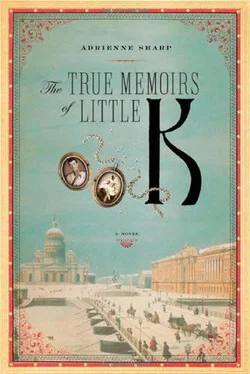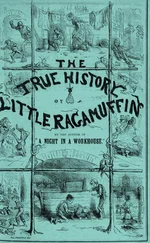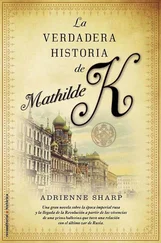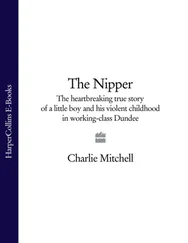Let us be frank. I did not jump well, I was not ethereal. My feet were flat. My legs were too short—to disguise this last defect I had special tutus made with short waists and long skirts—but my audience did not notice my deficits. They saw only that I was bold, that I was fast, that I was brilliant. I was what was called a terre-à-terre dancer—I attacked the floor with my sharp, hard pointes. Diamantine , I was described. I gave off light. And I was dancing for a court that loved nothing more than diamonds, glitter, gold. In addition to my formidable technique, I had the ineffable something that makes a dancer a star. When I stepped onto the stage, one could look nowhere but at me until I left it. Scenery, stage business, the divertissements of soloists or corps de ballet —none of it could distract from the impact of my presence. And I could act, if that is the word for what happens when one opens the door to a role and steps completely within it, the canvas backdrop, the painted face of one’s partner, more real than the walls of the auditorium and the men and women seated there. No one who has seen me as the tragic, bewitched Swan Queen Odette or the jilted Gypsy girl Esmeralda could ever forget it. When, as Esmeralda, I looked to heaven in the last act, my pain and my jealousy at Phoebus’s betrayal changing to resignation, there was no one in the theater immune to my pathos. And while pining, I was glamorous. I pinned to my hair a wig styled by the most fashionable hairdresser of the time, Delacroix, I fastened jewels, at first just glass but later the real precious stones given me by my admirers, at my wrists and my neck, and I cinched beneath my costume one of the whalebone corsets I had made especially for me in a Petersburg shop. One could not bend much so laced, but a straight stiff back was the vogue then on the stage and off. They laughed at me later, Mikhail Fokine and the newer choreographers, when they pioneered a newer, free-flowing dance style at the turn of the century. In his Petrouchka , the stiff-bodied ballerina doll with the whipping legs was a caricature of me invented by Fokine, with his beak of a nose, and his little friend, with her nose in the air, Bronislava Nijinska—a Polish girl like me with a brother, Vaslav, who would become much more famous than she ever would, despite her airs. When she later joined Diaghilev’s Ballets Russes along with her brother, she persuaded the older dancers not to wear their jewels on the stage, that it did not suit the character or costume to be so adorned. But that was the way we danced then in the 1890s—in corsets, in nineteenth-century three-act ballets, for emperors and kaisers and kings.
The court had already tired of venerating French, Italian, and German music, opera, literature, languages—where were our own? At the start of the nineteenth century, a parlor game in which the speakers could converse only in Russian became all the rage, and if one spoke, by mistake, a French word, his fellows would cry, Forfeiture —in French! because there was no word for this in Russian. It took Pushkin in the 1830s to give us our own language. But the Russian ballet of 1890 was still dominated by Europeans: imported Italian dancers and imported French ballet masters—Didelot, Perrot, St. Léon, and Petipa—woe to poor Lev Ivanov, who had the misfortune to be a Russian and therefore to be overlooked and under-paid as second ballet master to a Frenchman! I ask you, who looks to Italy or France for ballet now? It was Russia, under the Romanovs, that perfected the art, and I was its first Russian ballerina, not one of those Italian girls brought in to do the honors in the ballerina roles, while the Svetlanas and the Ekaterinas and the Olgas posed behind them. I was the first to learn the tricks of Zucchi and Grimaldi and Brianza and Legnani, the fouetté , the double tour , the entrechats sept royal . After my debut in January 1893 as Aurora in Sleeping Beauty —I am skipping ahead here again for a moment—Tchaikovsky himself came to my dressing room to tell me he wanted to create a ballet for me. It was like God calling on one. At my doorway, he bowed to me, his face very pink, his beard and hair almost entirely white, his dark-rimmed eyes glittering, his right hand playing with the pince nez he wore always on a black cord, and in his usual mishmash of French and Russian, he praised my dancing of Aurora. He was only fifty-two. We had just last year, on the fiftieth performance of The Sleeping Beauty , presented him on the stage a crown of gold laurel leaves. That’s how we honored our artists in tsarist Russia—with ceremony and treasure. I remember because I myself had been elected to present him the crown and I was late to the backstage ceremony, having been flirting with a trio of grand dukes—and the company, which knew this, seethed at the delay but could do nothing about it! Yes, Tchaikovsky thought he had years ahead of him of making ballets with the great Petipa, many more spectacles and féeries to mount. Tchaikovsky, Vzevolozhsky, and Petipa—and, yes, Ivanov—together created the three masterworks of the ballet repertory— The Sleeping Beauty , The Nutcracker , and Swan Lake —now danced by companies all over the world, pieces of that music played on out-of-tune pianos in ballet schools on every continent as young girls practice their battements and tendus . (And Tchaikovsky was so kind to students! After the first performance of his Nutcracker in 1882, he sent two big baskets of sweets to all of us at the school who had performed children’s roles in the ballet.) Petipa would send Tchaikovsky his notes—they each worked alone—then, in rehearsals on the little school theater stage, would have Tchaikovsky shorten or lengthen his music to suit his dances, though Petipa was deferential about it, for what serious composer could stand to work like this, on command take a scissor to his phrases? Tchai kovsky’s reputation suffered at first because he wrote for the ballet. We usually had hacks like Pugni, Drigo, or Minkus—men on the theater payroll as composers or conductors—create the music for our steps. Who listens to them now? No one. But everyone can hum a bar or two of Tchaikovsky. For Sleeping Beauty , Petipa sent Tchaikovsky notes, With a new wave of the fairy’s magic wand Aurora appears and rushes onstage. 6/8 for 24. A voluptuous adagio. Coquettish allegro—3/4 for 48. Variation for Aurora . From these plain details Tchaikovsky dreamed the richly embroidered music. Do you know what Alexander III said to Tchaikovsky about his music after the dress rehearsal of his magisterial Sleeping Beauty , performed before an invited royal audience? Very nice . Perhaps he thought Tchai kovsky was satirizing him in the person of the bumbling King Florestan, who could not properly supervise his courtiers and thereby doomed his court to one hundred years’ sleep. Tchaikovsky moped for days, always believing each of his triumphs to be a failure. Why, after the debut of his opera Queen of Spades , he walked the streets in despair until he heard three young officers singing the lines to one of the arias.
What music would Tchaikovsky have created for me? What story—for he created the story for his ballets, too; the libretto for Swan Lake was his own pastiche of fairy tales and bits of Wagnerian operas—would he have dreamed up to suit my talents? Perhaps Undine , the ballet he had thought about composing since 1886. Perhaps I was the final inspiration he needed? But I will never know, for Tchaikovsky died in the cholera epidemic later that year. Despite the large placards mounted everywhere in the city cautioning against drinking unboiled water, Tchaikovsky asked for a glass of it in a restaurant and drank it down like a man who wanted to die, a story that astonished me then, because I was young and knew nothing yet of the shame coiled about the body of love. When I went to the apartment of his brother Modeste, where Tchaikovsky was laid out in a black suit on a low bier draped in white satin, I could not understand how a man of his age, which seemed to me then so great, could still be driven by passion. I knew Tchaikovsky loved men, but I did not know until later that he was in love with his nephew and that his love was—even worse than forbidden—not returned. Was that hopelessness also my own? Before I kissed Tchaikovsky’s pale forehead, all his thoughts of love blanched away, someone standing at the head of the coffin wiped the composer’s nose and mouth with a cloth dipped in carbolic, and we were told to spit into a handkerchief of our own after giving to him our last kiss. Was it his disease or his torment we feared contracting? The emperor gave permission for the funeral service to be held in Kazan Cathedral, for which one needed a ticket, as if it were a performance, but for this goodbye, no one needed to reserve a seat. This farewell was for intimates, his fellow artists.
Читать дальше












